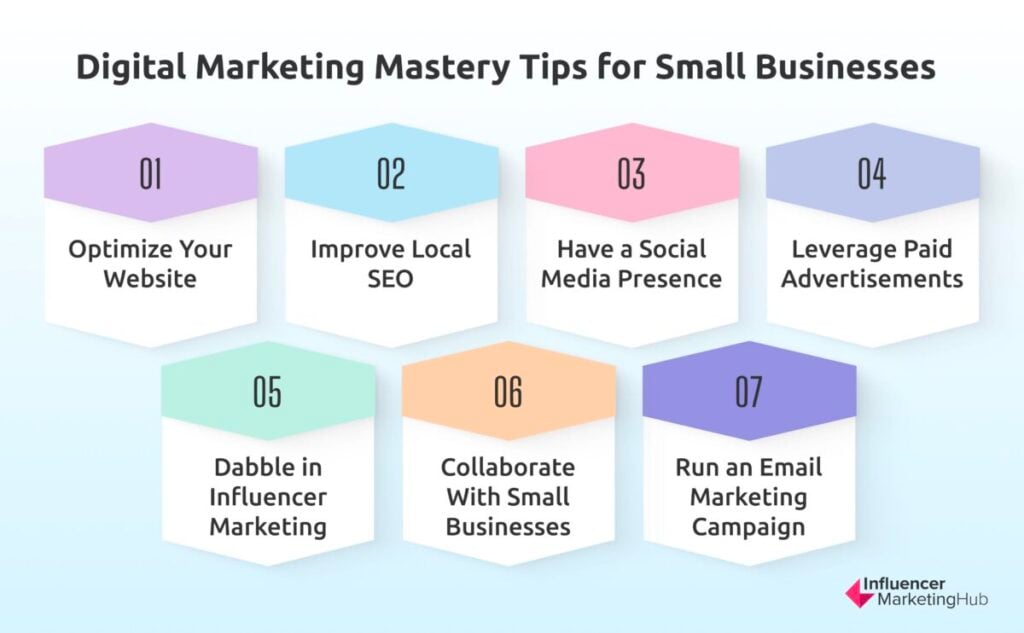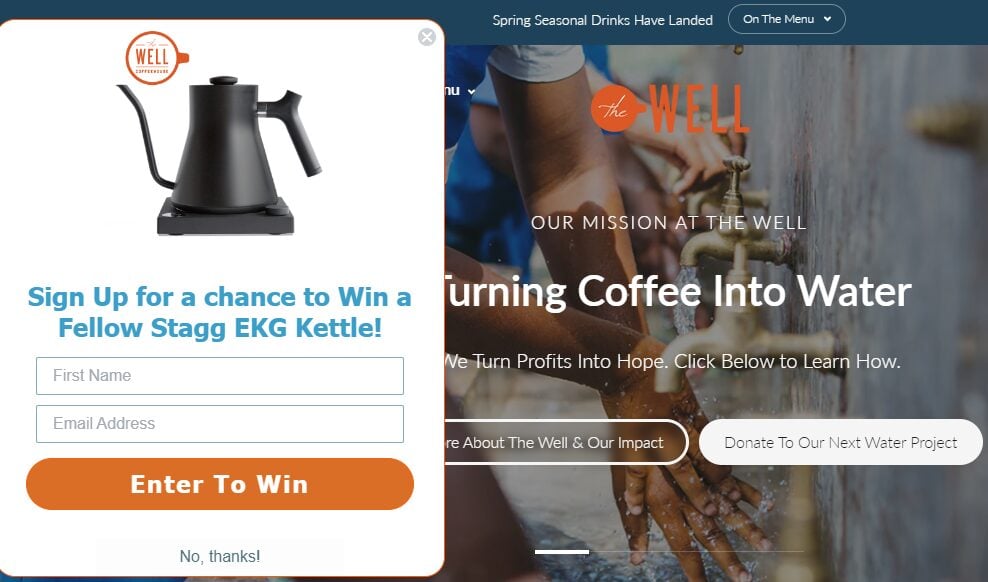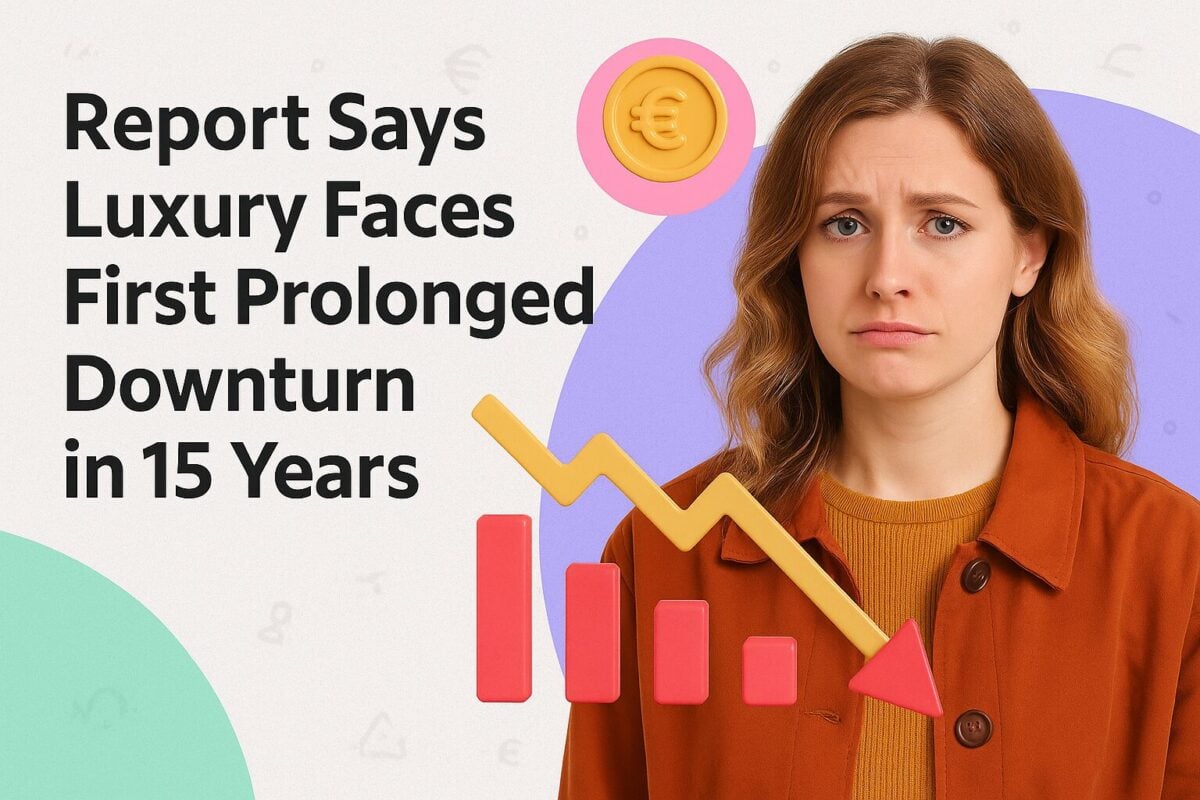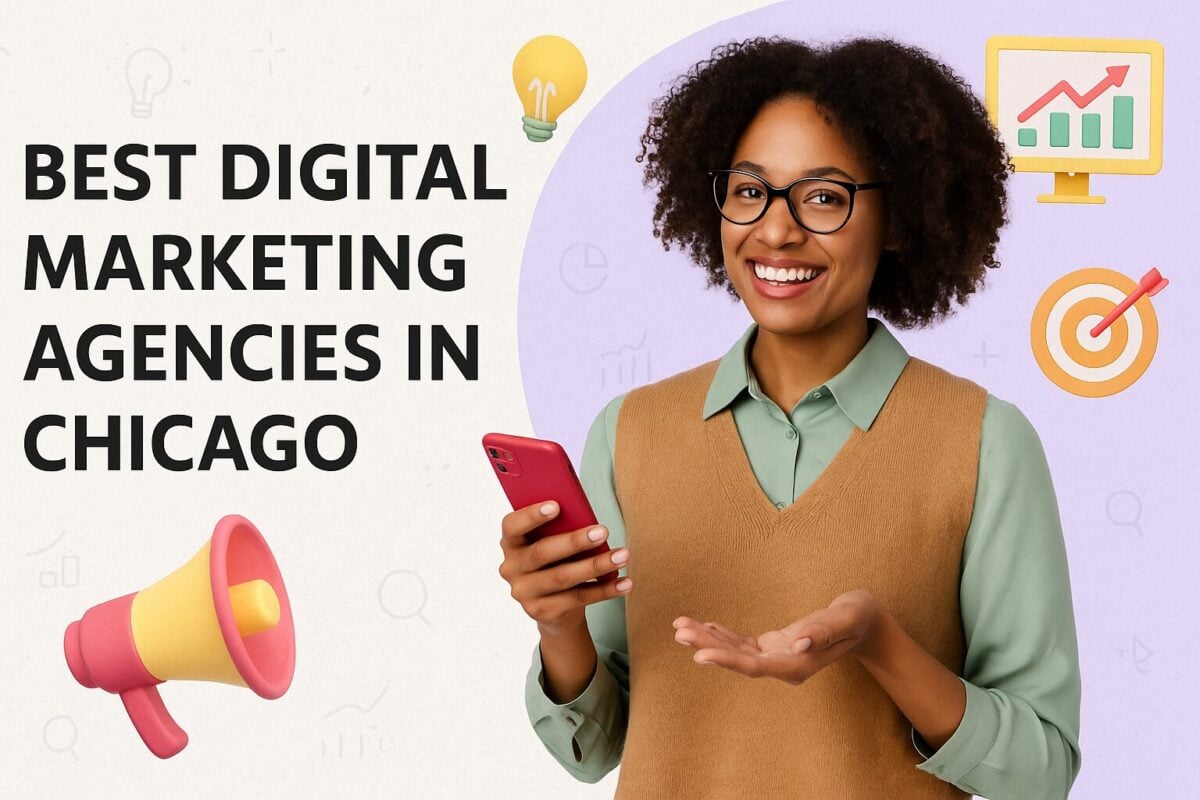In recent years, the number of small and medium enterprises (SMEs) has grown substantially, playing a vital role in global economies. McKinsey reports that SMEs contribute significantly to global economies. In fact,
''they contribute more than 50 percent of GDP in high-income countries worldwide.''
However, it's often harder for SMEs to stand out in a crowded marketplace, especially with limited resources. The good news is that the digital landscape gives businesses room to thrive even without excessive expenditure.
Small businesses with a decent, multi-platform digital marketing strategy can reach a wider audience and ultimately achieve growth. Below, we explore some key elements of digital marketing for small businesses.
Tips for Small Businesses to Master Digital Marketing
As a small business, there are a few things that will guide your marketing strategies.
First, your budget isn't as large as that of big corporations. Second, your products or services may be niche. So, you have to be more targeted in your marketing efforts. Third, you are likely to have a smaller team and limited time to devote to marketing.
Fourth, your customers are more likely to be local or regional, depending on the nature of your business. Keeping all these factors in mind, here are some useful digital marketing tips for small businesses:
1. Optimize Your Website
The first thing you must do as a small business is to optimize your website.
In the digital world, it's often the first point of contact between you and potential customers. So, you want it to be perfect SEO-wise.
According to research from FirstPage, the first organic result on the Google search results pages (SERPs) gets 39.8% of clicks. The first snippet gets 42.9% of clicks, while the first ad result receives 1.2 to 2.1% of the clicks.
These figures make a strong point about the importance of optimizing your website. There are two types of SEO that you should focus on:
On-page Optimization
On-page optimization means optimizing the elements on your website, including your content and HTML source code. It includes:
- Incorporating relevant keywords into your content
- Writing high-quality content that meets Google's guidelines
- Optimizing heading tags (H1, H2, etc.)
- Improving site speed
- Adding internal and external links in your web content
- Writing a keyword-rich meta title and meta description
Off-page Optimization
Off-page optimization includes all actions you take outside your website to improve its ranking on search engines. For example:
- Building backlinks from reputable websites
- Creating a presence on social media platforms
- Guest blogging on relevant and authoritative websites
Technical SEO
Similarly, optimization also includes technical touch-ups. It's imperative that your website is mobile-friendly since over 50% of web users are mobile. Google says,
''Mobile is close to our heart—we love seeing more and more sites make their content available in useful and accessible ways for mobile users.''
You know it's something you can't ignore.
Fix the broken links on your website and redirect visitors to the right page. Make sure your website is secure by obtaining a Secure Sockets Layer (SSL) certificate.
Also, set up an XML sitemap to make it easier for search engines to crawl and index your website. Brush up your robots.txt file to restrict search engines from crawling unnecessary pages, such as the checkout page on an e-commerce website.
Look for other technical issues in Google Search Console and fix them promptly.
2. Improve Local SEO
Small businesses with a brick-and-mortar location need local visibility rather than targeting a global audience. They need more foot traffic, and local SEO can help bring that.
Note that it's not a replacement for your regular SEO. It's merely a supplement.
First off, create a Google Business Profile. Optimize it by filling in all relevant fields, such as business name, contact details, working hours, address, website, location on the map, etc.

Local business listing on Google Business Profile
Then, use local keywords in your content. For example, instead of ''best child care center,'' use ''best child care center in New York.'' You can use a tool like Semrush's Keyword Magic to look specifically for local keywords.
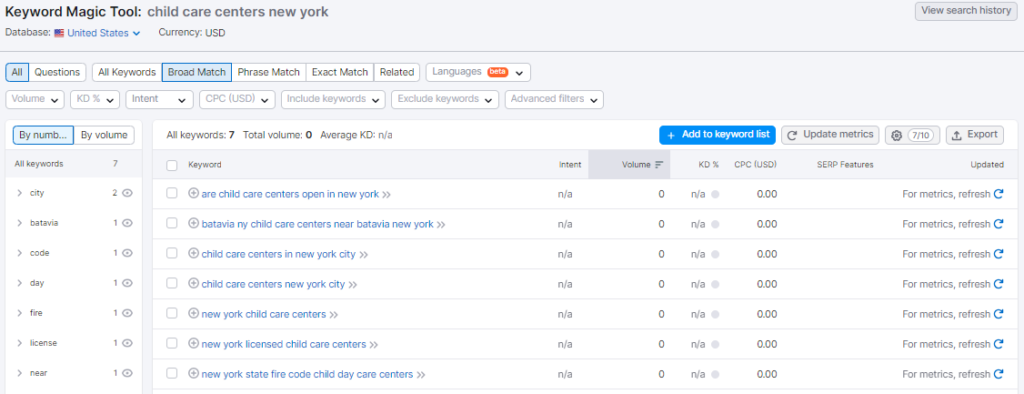
Semrush Keyword Magic tool
Also, get listed on local directories such as Yelp or Yellow Pages. Request your customers to leave reviews on these platforms as they contribute to your local SEO ranking.
You can also collaborate with local influencers to get the word out about your business. Suppose you're a child care center in New York. You can partner with a local mommy blogger to get valuable exposure.
Another way to improve local SEO is by using location-specific hashtags on social media. Locals who search for these hashtags may come across your business and check it out.
You can use our Hashtag Generator to create hashtags for your Instagram posts. Simply upload the image file, and our tool will generate relevant hashtags for it.
For more visibility, you can also run ads in the Google Business section. For example, Tutor Time of Saddle Brook uses Google Ads to boost its local visibility.

Google Ads example
Google Ads may give your business the initial boost it needs to get some traction on the web.
3. Have a Social Media Presence
Currently, 62.3% of the world's population is on social media, spending an average of 2 hours and 23 minutes daily. That's enough people and time for you to find your target audience and make an impact.
It's best to invest in a tool like Sprout Social to manage all your social media needs in one platform. For example, you can respond to comments and DMs from different social media platforms on SproutSocial without having to switch between apps.
SproutSocial also gives you insights into your social media performance. Plus, there are listening, advocacy, and automated publishing features. More importantly, you can measure your ROI from influencer marketing within SproutSocial.
Case Study:
Buff City Soap, a small soap-making business, reached 1.4 million new people with influencer marketing managed through SproutSocial.
Here are some additional tips to enhance your social media presence:
- Post content regularly.
- Follow social media trends and pop culture references to remain relevant.
- Follow the 80/20 rule. It states that only 20% of your posts should be promotional; the rest should provide value to your followers.
- Collaborate with other businesses to run campaigns or introduce new products.
- Work with influencers to increase your reach.
- Engage with your followers in comments and messages.
Brooki Bake House, an Australian baker, is an excellent example in this regard. The bakery has a profile on TikTok, Facebook, and Instagram. They post behind-the-scenes videos, day-in-the-life clips, and cake-decorating videos regularly.
@brookibakehouse
On Instagram, they use Reels to push their brand further.
They also post updates about new products on their Facebook page. Their Facebook Intro page is also fully optimized with the bakery's physical address, email address, website, operational hours, and ratings.
Your small business could be the next Brooki Bake House if you leverage social media properly.
4. Leverage Paid Advertisements
Paid advertisements can work wonders if you want to attract a large number of visitors to your website quickly. Online advertisements help you increase conversions, sign-ups, purchases, and subscriptions.
Generally, there are two types of online advertisements to choose from. The first is social media types.
You can advertise your website on platforms like Facebook, Instagram, Twitter, and LinkedIn. Select your demographic, and your ad will be shown to users who fit those criteria.
The second type is pay-per-click (PPC) advertisements. These are the ads you see on Amazon or Google. So, you will be advertising to people who are actively searching for your product or service.
For example, when we search for ‘’organic skincare brands,’’ the top result is a PPC ad. It’s a small business using Google Ads to increase online visibility.

PPC ads example
So, how do you choose between the two?
Run social ads if you want to improve brand awareness. PPC ads are better for reaching prospects who already have a purchase intent. You can learn more about running Amazon ads in our guide here.
5. Dabble in Influencer Marketing
No, you do not have to work with mega influencers who charge thousands of dollars for a single post. Work with micro-influencers instead. They have a smaller following but higher engagement rates. They’re also more affordable.
If you're a local business, local influencers should be your go-to. Small businesses offering digital services can work with micro-influencers from anywhere in the world.
Influencer marketing works because your customers are more likely to trust their favorite influencer than what you have to say about your brand yourself.
Don't limit influencer marketing to simply paying a person to talk about your brand. Instead, you can work with influencers for new product releases or to host giveaways.
For example, Blossom Beauty is a small cosmetics and personal care brand with a little over 24,000 followers on Instagram. The brand works with micro influencers to expand its reach.
The brand also has ambassadors, who are just regular customers who love the products and share their experiences on social media.
The combination of influencer marketing and brand ambassadors can help such businesses boost sales and build trust among potential customers.
6. Collaborate With Small Businesses
What better way to improve your reach than to join forces with another small business?
Collaborate with businesses that offer complementary products or services. Such collaborations give both businesses a chance to tap into each other's customer base.
For example, a small bakery can collaborate with a co-working space or a local coffee shop to offer a discount on a pastry and coffee combo. How does this help?
Both businesses get exposure to a new audience. Plus, the customers get a great deal, making them more likely to return.
Collaborations can also extend beyond just product promotions. You can work together on events and social media campaigns, too.
For example, a clothing boutique and a jewelry store can team up to host a fashion show or style session. If both businesses are really in sync, they can even co-create a product.
It's sort of like the Big Business x Even Bigger Business (e.g. Miu Miu X New Balance) collaborations but on a smaller scale.
Suppose your brand makes organic soaps and lotions. Collaborate with a local farm that produces organic oils and herbs to create a limited-edition soap infused with their ingredients.
It's a win-win for both businesses.
7. Run an Email Marketing Campaign
You might think the era of social media has given email marketing the boot, but that's far from true. Email marketing is still bringing in a whopping $36 for every $1 you spend.
So, it's worth exploring.
Growing your email list is often the hardest part. But you can do it by offering exclusive deals and discounts to subscribers.
For example, Well Coffee House gives users a chance to win a Fellow Stagg EKG Kettle in a lucky draw in exchange for their email address.
Similarly, Loving Labor Coffee has a rewards system, encouraging you to sign up with your email to earn 100 points. You can earn more points by placing an order and referring a friend.
After building a substantial email list, the next step is to create an email marketing campaign. Here are some things you can send in your emails:
- Promotional offers or seasonal discounts
- Welcome emails with a discount for first-time customers
- Blog post updates and other engaging content
- New product announcements
- Exclusive sneak peeks or early access to limited-edition products
- Personalized product recommendations based on your customer's past purchases
- Thank you emails
- Surveys to gather customer feedback
Monitor your campaign regularly to take note of what's working. Do more of what's giving you better results and tweak the things that are not performing well.
Also, include call-to-actions (CTAs) in your emails to guide customers toward the desired action, such as leaving a review or making a purchase from your new collection.
Conclusion
The bottom line in digital marketing for small businesses is to be present where your target audience is, be it the web, social media, or local events.
You don't have to go all out all at once. Instead, start small with website optimization and a social media presence.
Once you have enough resources, you can try advertisements and influencer marketing. After you build a decent brand, you can go on to collaborate with other businesses.
Frequently Asked Questions
How do I start digital marketing for my small business?
Start by identifying your target audience through competitor analysis and market research. Optimize your website and create social media pages. Then, gradually try other digital marketing tactics as you gain more resources and followers.
Does digital marketing work for small businesses?
Digital marketing works for any business that uses it right. Small businesses with limited personnel and resources should leverage digital marketing tools to automate and manage their campaigns effectively.
What is SEO in digital marketing?
Search engine optimization (SEO) means optimizing your online content for the search engines. In simple words, it involves any and every task that makes your web content more search-engine-friendly i.e., in line with search engine algorithms and content guidelines.
What is ROI in digital marketing?
ROI means return on investment. It measures the profitability or success of a marketing campaign by comparing the amount spent to the revenue generated.
Is SEO enough for digital marketing?
SEO is just one aspect of digital marketing. It should be used in combination with other tactics, like social media marketing, email marketing, influencer marketing, paid advertisements, and content marketing, to have a comprehensive digital marketing strategy.
